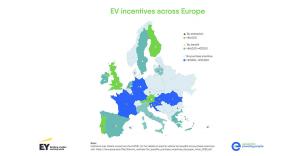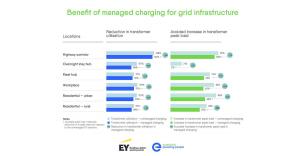European electricity grid can support 100+ million electric vehicles, new Eurelectric-EY study reveals
European electricity grid will remain stable despite exponential growth of the EV market and high electrification ambitions, reveals a new Eurelectric-EY study.
BRUSSELS, BELGIUM, February 16, 2022 /EINPresswire.com/ -- The EV revolution is on a tear and the electricity grid will remain stable despite exponential growth of the EV market and high electrification ambitions, reveals a new Eurelectric-EY study. But timely planning of charging infrastructure and coordination between public authorities, electricity utilities, grid and charge point operators will be paramount to success.
“Electrification is now an irreversible megatrend in road transport. The challenge ahead is speeding up infrastructure rollout in a well-coordinated manner to respond to growing charging needs while ensuring the optimal use of the electricity network,” says Jean-Bernard Lévy, Eurelectric’s President and CEO of French electricity utility EDF.
A 40-fold electric vehicle market expansion by 2035
There will be 130 million electric vehicles (EVs) on Europe’s roads by 2035, up from 3.3 million today, reveals the Eurelectric-EY study unveiled during EVision - Eurelectric’s event on e-mobility.
“[...]Moving into the mass market, public charging infrastructure is a key success factor,” said Sara Riera, Head of energy & charging at SEAT and speaker on the “Ensuring the right regulatory framework for e-mobility acceleration” panel.
Rolling out charging infrastructure
“We must break the chicken and egg dilemma. We now need also to focus on charging infrastructure – we cannot rely only on public charging,” emphasized Adina Valean, EU Commissioner for Transport during her conversation with Kristian Ruby, Eurelectric’s Secretary General.
By 2035, 65 million chargers need to be installed to keep up with the EV market growth. Of those, 85% will be residential, 6% in the workplace, 5% at the destination and 4% on public highways.
“To accelerate EV uptake, we need to make e-mobility work for the customer. With significant investment in the grid and in digital solutions, utilities are key to winning customers’ hearts and minds,” said Serge Colle, EY’s Global Energy & Resources Industry Market Leader.
Today, charging infrastructure in Europe is patchy, with perceivable disparities between and within countries.
“We need to make the rollout less ‘spotty’. We need to harmonise, and both the European Commission and Member States can help, outlined Åsa Pettersson, Swedenergy CEO during the opening session of EVision.
Existing bottlenecks such as permitting and grid delays of up to 36 months, funding constraints, and interoperability restrictions, must therefore be urgently tackled.
“Eliminating the bottlenecks is critical to making customers feel comfortable with owning an EV,” said Miguel Stilwell d’Andrade, EDP CEO during the opening session of EVision.
Electricity grid copes despite higher electricity demand
The more charging infrastructure and EVs, the greater the demand on the electricity grid. Electricity demand from EVs will increase by 11% annually, adding 200TWh by the end of this decade.
Once EV penetration reaches 50% on an urban distribution network, uncontrolled charging could lead to voltage deviations and affect the quality of power supply. Peak load could increase by 90% on highway corridors, while in multi-dwellings blocks, charging could increase peak load by 86%.
The electricity grid will be able to accommodate the transition to EVs, but advance planning and coordination are needed to ensure that it copes with future peaks in electricity demand.
“Cooperation and partnership among all stakeholders are very critical to deliver high-value interoperable services,” explained Kyriakos Kofinas, Chief E–Mobility Officer at the Greek Public Power Corporation during a panel on accelerating customer acceptance.
How can utilities turn EVs into grid assets?
The study explores several mitigating solutions. While ensuring that charge points are situated where they deliver maximum customer convenience and provide the right investment incentives, Eurelectric recommends the urgent implementation of several measures.
Digitalising the grid will be key to understanding, anticipating and optimising customer behaviour, impacts and network needs. Managed charging, either via supplier-managed smart charging or a user-managed response to time-of-use tariffs, will allow for load shifting, dampening the spike in peak load by up to 21% (compared to unmanaged charging).
“Part of the grids have not been designed for the massive integration of renewables and the evolution of e-mobility. Smart charging is what makes everything possible,” said Markus Mildner CEO eMobility, at Siemens Smart Infrastructure during a panel on e-mobility and the four laws of ecology.
Deploying smart technologies, such as smart grids, meters and chargers are key to manage capacity and prevent the grid from buckling under the pressure of millions of EVs plugging in simultaneously.
In time, vehicle-to-grid (V2G) solutions will allow power that is stored in EVs to be pushed back to the grid, or to a building such as a home, office or factory, to balance energy production and consumption.
Similarly, Polestar’s Managing Director Lies Eeckman highlighted the importance of vehicle-to-X technologies: “Considering an EV battery capacity of 78 kilowatts, you can provide energy to an average European household for days.”
Integrating energy storage solutions in the charging infrastructure will play a key role when demand for rapid and high-power charging is heightened. Moreover, EVs and stationary batteries could provide valuable balancing services, reducing charging operations’ dependency on local grids. In recognising this role, the double taxation of electricity storage should be avoided.
“By 2030, we’re expecting about 14 million EVs in the UK. If we just take 10 million of those and we are giving energy back to the grid with a typical vehicle to grid (V2G) charger, that can power the whole of the UK at peak time,” highlighted Fiona Howarth, CEO of Octopus Electric Vehicles during the EVision session on the role of businesses in accelerating e-mobility.
What’s next ?
Two dozen movers and shakers from across the automotive, electricity, and technology world envisioned an electric future at EVision2022.The conversation does not stop here. As we push the pedal to the metal to decarbonise our economy, the EVision Business Hub offers market players in and beyond the power sector, the perfect avenue to explore operational challenges and mutually beneficial solutions to unleash the power of e-mobility.
Ioana Petcu
Eurelectric
+32 470 45 35 89
email us here
EVision launch
Legal Disclaimer:
EIN Presswire provides this news content "as is" without warranty of any kind. We do not accept any responsibility or liability for the accuracy, content, images, videos, licenses, completeness, legality, or reliability of the information contained in this article. If you have any complaints or copyright issues related to this article, kindly contact the author above.



